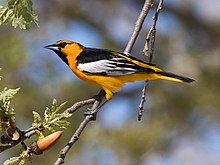Icterid
| Icterids | |
|---|---|
 |
|
| Adult male Bullock's oriole | |
| Scientific classification | |
| Kingdom: | Animalia |
| Phylum: | Chordata |
| Class: | Aves |
| Order: | Passeriformes |
| Suborder: | Passeri |
| Family: |
Icteridae Vigors, 1825 |
| Genera | |
|
29, See text |
|
29, See text
Icterids make up a family (Icteridae) of small- to medium-sized, often colorful, New-World passerine birds. Most species have black as a predominant plumage color, often enlivened by yellow, orange or red. The family varies widely in size, shape, behavior and coloration. The name, meaning "jaundiced ones" (from the prominent yellow feathers of many species) comes from the Ancient Greek ikteros via the Latin ictericus. This group includes the New World blackbirds, New World orioles, the bobolink, meadowlarks, grackles, cowbirds, oropendolas and caciques.
Despite the similar names, the first groups are only distantly related to the Old World common blackbird (a thrush) or the Old World orioles.
The majority of icterid species live in the tropics, although there are a number of temperate forms, such as American blackbirds and the long-tailed meadowlark. The highest densities of breeding species are found in Colombia and in southern Mexico. They inhabit a range of habitats, including scrub, swamp, forest, and savanna. Temperate species are migratory, with many species that nest in the United States and Canada moving south into Mexico and Central America.
Icterids are variable in size, and often display considerable sexual dimorphism, with brighter coloration and greater size in males being typical. While such dimorphism is widely known in passerines, the sexual dimorphism by size is uniquely extreme in icterids. For example, the male great-tailed grackle is 60% heavier than the female. The smallest icterid species is the orchard oriole, in which the female averages 15 cm in length (6 in) and 18 grams (0.040 pounds) in weight, while the largest is the Amazonian oropendola, the male of which measures 52 cm (20 in) and weighs about 550 grams (1.21 pounds). This variation is greater than in any other passerine family (unless the kinglet calyptura belongs with the cotingas, which would then have greater variation). One unusual morphological adaptation shared by the icterids is gaping, where the skull is configured to allow them open their bills strongly rather than passively, allowing them to force open gaps to obtain otherwise hidden food.
...
Wikipedia
